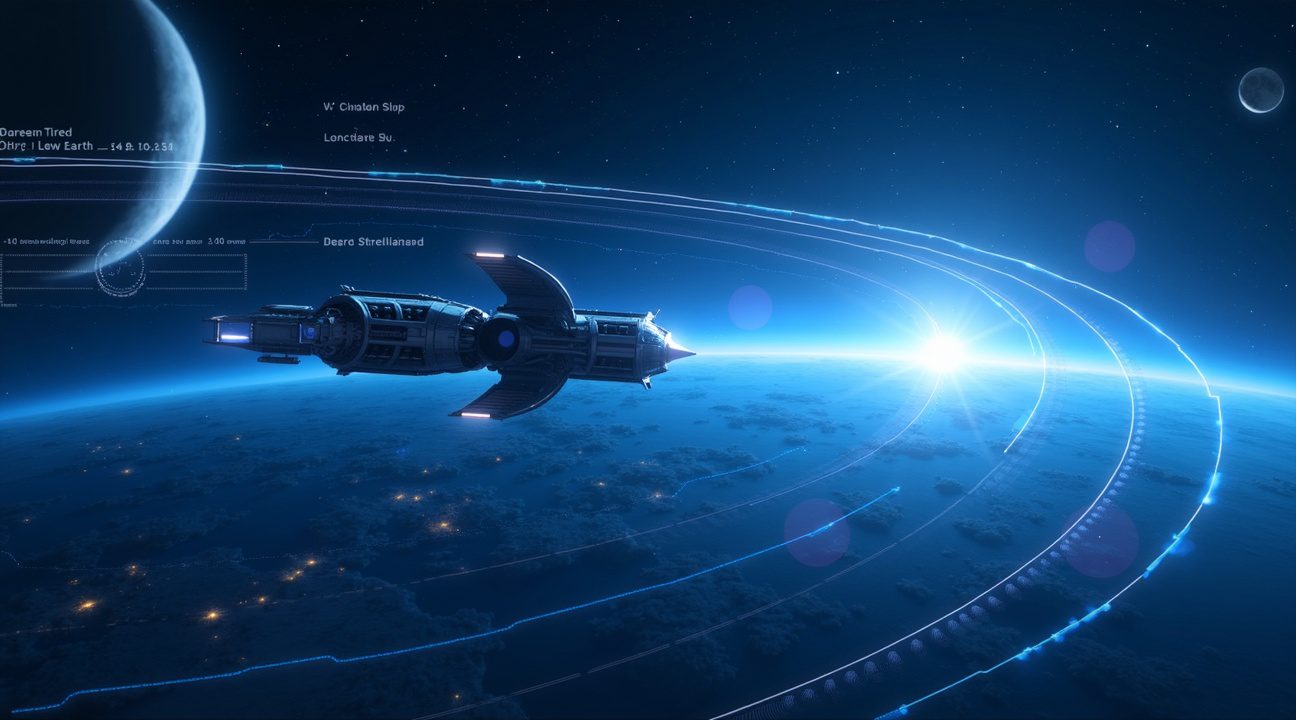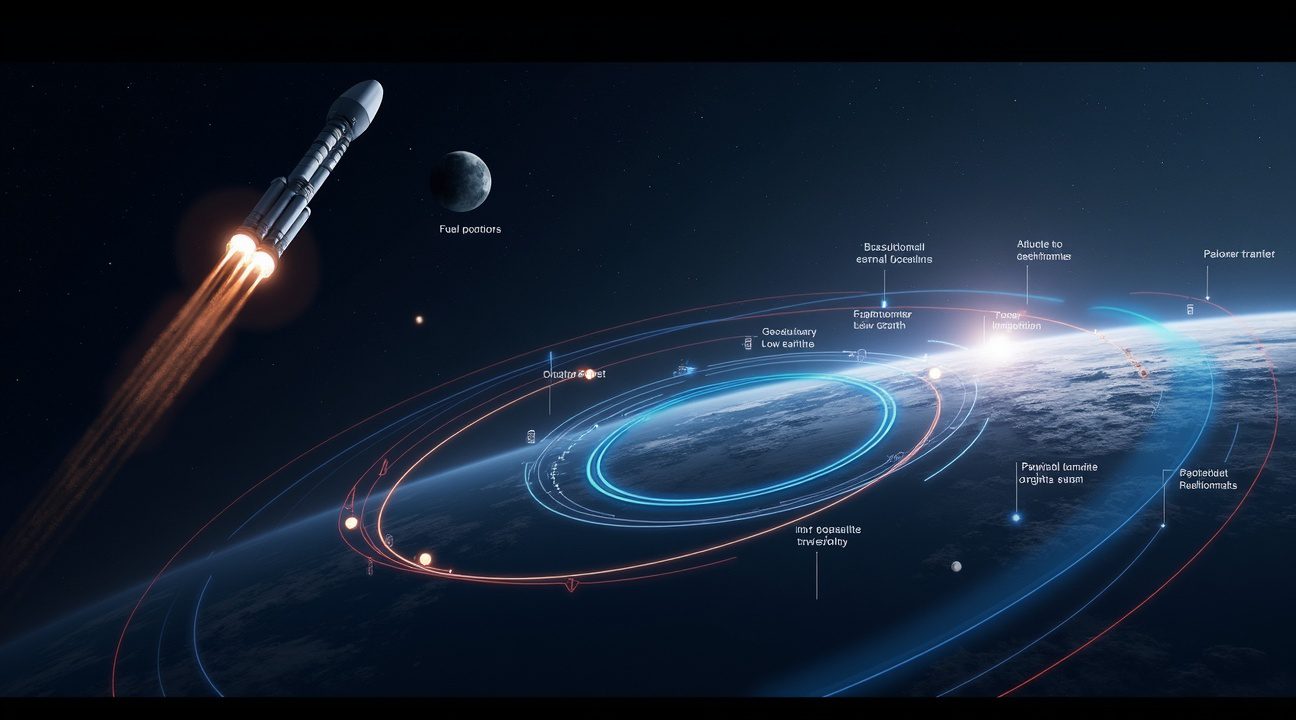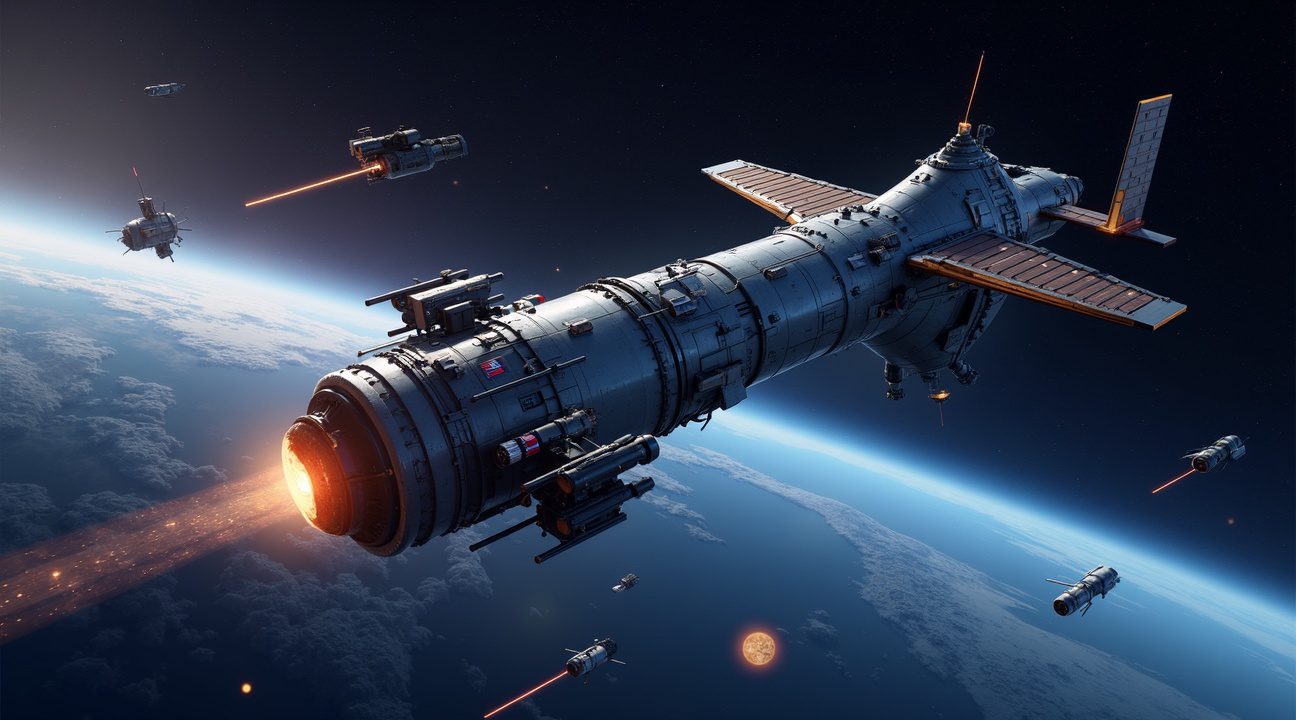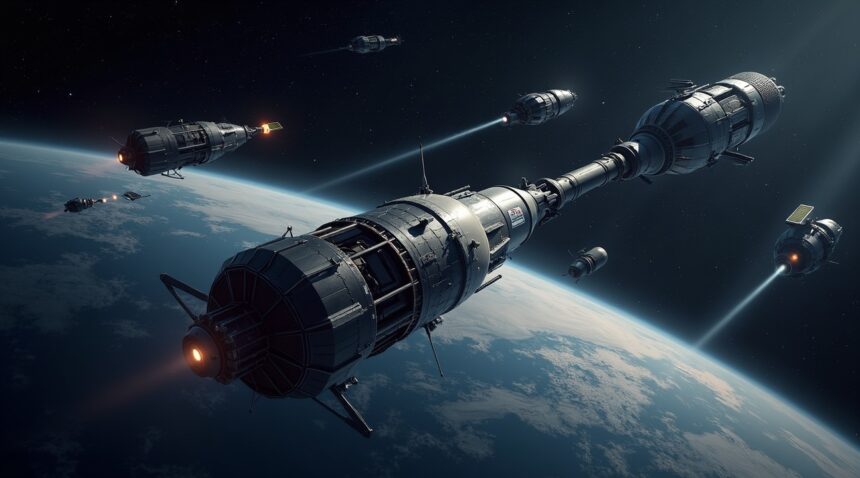NASA has awarded $1.4 million to six aerospace companies, including Blue Origin, United Launch Alliance (ULA), and Rocket Lab, to pioneer orbital transfer vehicles—spacecraft designed to access hard-to-reach orbits and deep space destinations currently beyond the efficiency of traditional rockets.
Key Takeaways
- NASA allocated $1.4 million across six companies to develop orbital transfer vehicles for hard-to-reach destinations, with studies due by September 2025.
- Traditional rockets encounter significant limitations when delivering payloads to complex orbits, high-inclination paths, or deep space destinations due to excessive fuel requirements for orbital plane changes.
- Each company contributes distinct expertise – Blue Origin concentrates on AI-enhanced surveillance platforms, ULA develops space interceptor capabilities, and Rocket Lab emphasizes cost-effective reusable systems.
- The new delivery system offers dual advantages of reducing mission costs while enabling unprecedented scientific capabilities through multi-orbit deployments and flexible mission planning.
- Long-term applications extend to deep space exploration including lunar gateway operations, Mars communication networks, asteroid rendezvous missions, and establishing sustainable supply chains for future space colonies.
Overcoming Current Orbital Limitations
The space industry faces significant challenges when attempting to reach specific orbital destinations. Current rocket technology often proves inadequate for missions requiring complex orbital maneuvers or extended journeys beyond Earth’s immediate vicinity. These limitations stem from fundamental physics constraints that govern spacecraft propulsion and energy requirements.
Traditional launch vehicles excel at placing payloads into standard orbits but struggle with specialized trajectories. High-inclination orbits, sun-synchronous paths, and geostationary transfers demand enormous fuel expenditures that make missions prohibitively expensive or technically impossible. The orbital transfer vehicle concept addresses these challenges by serving as an intermediate step between initial launch and final destination.
Company Contributions and Innovations
Blue Origin’s AI-Driven Navigation
Blue Origin approaches this challenge through AI-enhanced surveillance platforms that can adapt to changing mission requirements. Their technology focuses on intelligent navigation systems that optimize fuel consumption while maintaining precise positioning capabilities. This approach enables extended mission durations and multiple payload deployments from a single transfer vehicle.
United Launch Alliance’s Precision Maneuvering
United Launch Alliance (ULA) brings decades of launch experience to the orbital transfer vehicle development program. Their space interceptor capabilities demonstrate advanced maneuvering technologies that translate directly to civilian and scientific applications. ULA’s systems emphasize reliability and precision — critical factors for missions involving expensive scientific instruments or time-sensitive deployments.
Rocket Lab’s Reusable Systems
Rocket Lab distinguishes itself through cost-effective reusable systems that make frequent orbital transfers economically viable. Their approach prioritizes efficiency and standardization, creating transfer vehicles that can support regular cargo runs between different orbital zones. This capability proves essential for establishing sustainable space infrastructure.
NASA’s Goals and Industry Urgency
The September 2025 deadline for study completion reflects NASA’s urgency in developing these capabilities. Current space missions often face years-long delays due to orbital mechanics constraints that limit launch windows and destination accessibility. Orbital transfer vehicles eliminate many of these restrictions by providing flexible transportation options that adapt to mission requirements rather than constraining them.
Driving Down Cost and Expanding Scientific Horizons
Cost reduction represents a primary driver behind this initiative. Traditional approaches to reaching challenging orbits often require custom-built rockets or complex multi-stage missions that multiply expenses exponentially. Transfer vehicles amortize their development costs across multiple missions while reducing per-payload transportation expenses through shared infrastructure and standardized operations.
Scientific capabilities expand dramatically when missions gain access to previously unreachable destinations. Multi-orbit deployments enable comprehensive Earth observation networks that provide continuous global coverage. Flexible mission planning allows scientists to adjust observation schedules based on emerging phenomena or changing research priorities.
Deep Space Applications with Transformative Potential
- Lunar gateway operations require reliable transportation systems that can ferry supplies and equipment between Earth orbit and the lunar vicinity. These vehicles provide the missing link in establishing permanent lunar infrastructure.
- Mars communication networks depend on precisely positioned relay satellites that maintain constant contact between Earth and Mars surface operations. Orbital transfer vehicles enable the deployment and ongoing maintenance of these assets.
- Asteroid rendezvous missions benefit from enhanced maneuverability and support the delivery of scientific instruments to multiple locations, increasing mission returns.
- Sustainable space colonies need regular logistics chains. These transfer vehicles lay the groundwork for reliable supply deliveries to diverse orbital points.
Strategic Vision for the Future of Space Transportation
The $1.4 million investment represents a strategic commitment to advancing space transportation capabilities beyond current limitations. Each participating company contributes specialized expertise that addresses different aspects of the orbital transfer challenge, creating a comprehensive development program that maximizes innovation potential.
Success in this program will establish American leadership in next-generation space transportation while opening new possibilities for scientific exploration and commercial space development. The technologies developed through this initiative will support decades of future missions across the solar system.
NASA Awards $1.4 Million to Six Companies for Revolutionary Space Delivery System
NASA has distributed $1.4 million in funding across six companies to develop groundbreaking orbital transfer vehicles that can reach previously inaccessible destinations in space. This strategic investment represents a significant step forward in expanding humanity’s reach beyond traditional orbital paths.
The space agency selected Blue Origin, United Launch Alliance, and Rocket Lab among the six recipients to conduct nine comprehensive early-stage studies. These companies will focus their research on creating spacecraft capable of accessing hard-to-reach orbits both around Earth and in the vast expanse of deep space. The funding distribution allows each company to explore innovative approaches to space transportation challenges that have limited mission possibilities for decades.
Companies participating in this program face a critical deadline of mid-September 2025 to complete their initial studies. This timeline pushes teams to rapidly develop concepts that could revolutionize how spacecraft move between different orbital regions. The compressed schedule reflects NASA’s urgency to advance these technologies and potentially integrate them into future mission architectures.
Strategic Focus on Hard-to-Reach Destinations
The emphasis on hard-to-reach orbits addresses a fundamental limitation in current space transportation capabilities. Traditional spacecraft often struggle to efficiently maneuver between different orbital planes or reach distant destinations without consuming excessive fuel. These new orbital transfer vehicles could unlock access to previously prohibitive mission profiles, enabling scientific discoveries and commercial opportunities that weren’t feasible before.
Several key advantages emerge from developing these advanced transfer systems:
- Enhanced mission flexibility for satellite deployment and repositioning
- Improved access to lunar and interplanetary trajectories
- Reduced fuel requirements for complex orbital maneuvers
- Extended operational lifespans for space assets through efficient transfers
- Cost-effective solutions for multi-destination missions
The participating companies bring diverse expertise to this challenge. Blue Origin’s experience with reusable rocket technology positions them well for developing efficient transfer systems. United Launch Alliance contributes decades of launch vehicle experience and mission planning expertise. Rocket Lab offers innovative small satellite launch capabilities and emerging space systems development.
This funding initiative connects directly to NASA’s broader exploration goals, including lunar missions and eventual Mars expeditions. The massive slingshot project trials demonstrate NASA’s commitment to advancing propulsion technologies. Similarly, ongoing developments in suborbital flight capabilities show how various transportation technologies complement each other in expanding space access.
The deep space applications of these orbital transfer vehicles could prove particularly transformative. Current missions to distant destinations require complex trajectory planning and often face strict launch windows. Advanced transfer systems could provide more flexible departure schedules and enable spacecraft to reach multiple targets during single missions.
Private industry partnerships like this funding arrangement accelerate technological development while leveraging commercial innovation. Companies can pursue ambitious concepts with reduced financial risk, while NASA gains access to diverse approaches and rapid prototyping capabilities. This model has proven successful in previous space technology development programs.
The international space community is also advancing similar technologies, as evidenced by recent achievements like the Chandrayaan 3 moon mission and continued progress from companies like SpaceX in space exploration. This competitive environment drives innovation and pushes all participants to develop more capable systems.
Future applications for these orbital transfer vehicles extend beyond government missions. Commercial satellite operators could use these systems for constellation management and orbit optimization. Space tourism companies might employ them to reach unique destinations that aren’t accessible through conventional launch profiles. The potential for commercial space flights continues expanding as transportation capabilities improve.
The September 2025 deadline will mark a crucial milestone in determining which concepts show the most promise for full development. NASA will evaluate the study results to identify technologies worthy of additional investment and potential integration into upcoming mission plans.

Orbital Transfer Vehicles: Space Tugs That Could Transform Mission Planning
Orbital transfer vehicles function as sophisticated space “tugs,” launching atop traditional rockets and delivering other spacecraft to specific, often challenging orbital destinations. I view these OTV systems as game-changers for mission planners who’ve been constrained by the limitations of conventional launch approaches.
Why Traditional Rockets Fall Short
Rockets expend most of their fuel during the initial liftoff phase, making it highly impractical for them to directly insert payloads into complex orbits. Standard launch vehicles typically deliver payloads only to low Earth orbit or geostationary orbit, leaving mission designers with limited options. This constraint has forced engineers to accept suboptimal orbital positions or invest in expensive, custom launch solutions.
The Multi-Orbit Solution
OTV projects target moving risk-tolerant payloads as an initial step, with the eventual goal of servicing larger, more valuable, and less risk-tolerant satellites or missions. This multi-orbit approach offers several advantages that I find particularly compelling:
- Enhanced flexibility for mission planners who need access to cislunar space
- Cost reduction for deploying multiple payloads to different orbital destinations
- Extended mission capabilities for spacecraft requiring high-inclination orbits
- Improved efficiency for complex orbital maneuvers that would otherwise require excessive fuel
Emerging science and defense missions increasingly require access to more complex orbits beyond the traditional options. NASA’s innovative projects demonstrate how space agencies are pushing boundaries to reach previously inaccessible orbital destinations.
The space tug concept addresses a fundamental challenge I’ve observed in modern space operations: the growing mismatch between launch capabilities and mission requirements. While SpaceX launches have revolutionized access to space, they still face limitations when deploying payloads to specialized orbits.
Cislunar space missions particularly benefit from OTV technology, as this region between Earth and the Moon requires precise orbital insertion that traditional rockets struggle to achieve efficiently. I expect these vehicles will become essential for future lunar operations and deep space exploration initiatives.
The risk-tolerant payload approach allows NASA to test and refine OTV technology before committing high-value assets to these systems. This methodical progression ensures reliability while building confidence in the technology’s capabilities for more critical missions.

Why These Orbits Are So Challenging to Reach
Getting spacecraft to specific orbits around Earth and beyond space presents complex engineering challenges that push current launch systems to their limits. The main difficulty stems from the enormous velocity changes required to reach these specialized orbital positions.
The Physics Behind Orbital Challenges
Primary rockets face significant fuel limitations when attempting to deliver payloads directly to hard-to-reach orbits. These challenging destinations often demand substantial velocity changes that can exceed what conventional launch vehicles can efficiently provide. The problem becomes even more complicated when missions require inclination changes—adjustments to the orbital plane that consume massive amounts of propellant.
Traditional launch systems optimize their performance for reaching basic orbits like low Earth orbit or geostationary transfer orbit. However, missions targeting polar orbits, highly elliptical orbits, or deep space trajectories require additional energy that strains fuel capacity. NASA recognizes that suborbital flight technology represents just one piece of the puzzle in advancing space transportation capabilities.
Multi-Orbit Delivery Demands
The commercial space market has created unprecedented demand for multi-orbit delivery capabilities. Companies now require launch services that can deploy multiple spacecraft across different orbital planes during a single mission. This approach maximizes cost efficiency while meeting diverse customer needs.
Current launch systems struggle with these multi-orbit requirements because they lack the flexibility to perform multiple significant maneuvers after initial deployment. The fuel needed for such complex orbital choreography often exceeds what primary rockets can carry while maintaining payload capacity. This limitation has created a bottleneck in the growing commercial space delivery market.
Orbital Transfer Vehicles (OTVs) offer a solution by handling the more difficult maneuvers after the primary rocket completes its optimized ascent. These specialized spacecraft can carry the additional propellant needed for complex orbital changes without compromising the main launch vehicle’s efficiency. The approach allows rockets to focus on what they do best—getting payloads off Earth’s surface—while OTVs manage the precise orbital positioning.
The strategy becomes particularly valuable for missions requiring spacecraft deployment across multiple inclination angles. Traditional launches might need several separate missions to achieve what a single rocket paired with capable OTVs could accomplish. This efficiency gain directly addresses the commercial market’s need for cost-effective access to diverse orbital destinations.
Space agencies worldwide have recognized these challenges, with projects like lunar missions demonstrating the complexity of reaching distant targets. Even commercial space ventures must grapple with these fundamental physics limitations when planning ambitious missions.
The fuel limitation problem becomes more acute as missions target increasingly challenging destinations. Deep space missions require velocity changes that can reach several kilometers per second beyond what’s needed for basic Earth orbit. These energy requirements create a mathematical constraint that forces mission planners to choose between payload mass and destination accessibility.
NASA’s focus on developing new spacecraft capabilities addresses these fundamental challenges by creating vehicles specifically designed for high-energy orbital maneuvers. The agency understands that future space operations will depend on having flexible systems that can reach any required orbit efficiently. This capability becomes essential as the space economy expands and missions become more complex.
Commercial customers increasingly demand launch services that can deliver payloads to precise orbital positions without requiring separate dedicated missions. The multi-orbit delivery approach represents a fundamental shift in how space transportation operates, moving from simple point-to-point delivery to comprehensive orbital logistics services. OTVs enable this transformation by providing the specialized propulsion needed for complex orbital operations while keeping primary launch costs manageable.

Company-Specific Approaches to Orbital Transfer Technology
Private aerospace companies are developing distinct solutions for NASA’s next-generation spacecraft requirements, each bringing specialized expertise to orbital transfer challenges. I’ve observed how these industry leaders focus on different aspects of space mobility, from military applications to commercial satellite deployment.
Blue Origin’s AI-Enhanced Platform
Blue Origin centers its orbital transfer vehicle development around the Blue Ring spacecraft, which incorporates advanced artificial intelligence for space surveillance operations. The company’s approach emphasizes autonomous navigation capabilities that can adapt to changing orbital conditions without constant ground control intervention. Their AI-powered sensors enable real-time threat detection and orbital debris tracking, making Blue Ring particularly valuable for both commercial and defense applications. NASA’s slingshot project trials align with Blue Origin’s focus on innovative propulsion methods that could complement their AI surveillance systems.
Blue Origin’s platform design prioritizes modularity, allowing different payloads and mission configurations on the same basic spacecraft architecture. This flexibility makes their orbital transfer vehicle suitable for multiple mission types, from satellite deployment to deep space preparation staging.
Defense-Focused Innovations
United Launch Alliance takes a distinctly different approach by upgrading their Vulcan Centaur rocket system into what they call a space interceptor for orbital defense missions. ULA’s strategy concentrates on rapid response capabilities that can address threats to critical satellite infrastructure. Their space interceptor concept enables quick deployment to protect high-value assets in various orbital zones.
Rocket Lab pursues yet another direction with their Neutron rocket program, which includes plans for ocean-based landing and recovery systems. Their orbital transfer vehicle research focuses on cost-effective solutions for frequent missions to hard-to-reach orbits. Rocket Lab’s emphasis on reusability through sea landing operations could significantly reduce mission costs for NASA’s ambitious deep space objectives.
Each company addresses specific mission requirements that NASA outlined for challenging orbital destinations:
- Blue Origin: Surveillance capabilities support space situational awareness.
- ULA: Interceptor technology enhances orbital security.
- Rocket Lab: Cost-reduction focus through reusable systems makes frequent missions more economically viable.
These complementary approaches create a comprehensive ecosystem for NASA’s orbital transfer needs, whether for commercial space flights or complex deep space missions.
The diversity in company strategies reflects the multifaceted nature of modern space operations, where orbital debris management, defense capabilities, and commercial viability must all factor into spacecraft design decisions.
Cost Savings and Scientific Breakthroughs Expected from New Delivery System
NASA’s ambitious initiative promises to revolutionize space exploration economics while unlocking unprecedented scientific opportunities. According to Joe Dant of NASA, these awards “will increase unique science capability and lower the agency’s overall mission costs.” This dual benefit represents a fundamental shift in how the agency approaches complex space missions.
Financial Advantages Drive Mission Evolution
The cost reduction benefits extend far beyond simple budget cuts. NASA expects this new delivery system to eliminate the expensive single-use spacecraft models that have dominated space missions for decades. Traditional missions required dedicated launch vehicles and custom-built spacecraft for each destination, creating substantial financial barriers for smaller scientific projects.
This approach enables NASA to pursue multiple objectives simultaneously, spreading mission costs across several payloads rather than funding separate launches. The agency can now consider previously unfeasible missions that were too expensive under conventional models. Commercial space companies benefit equally, as they can offer standardized services across multiple missions rather than developing costly one-off solutions.
Mission planners gain flexibility to adjust destinations and objectives during flight phases, something impossible with rigid single-destination architectures. This adaptability reduces the risk of total mission loss while maximizing scientific return on investment. SpaceX launch innovations have already demonstrated how reusable systems can dramatically cut operational expenses.
Rising complexity in space operations demands increasingly sophisticated delivery capabilities. Modern scientific missions require instruments positioned at multiple orbital locations to gather comprehensive data sets. Climate monitoring satellites need specific orbital configurations that traditional launch systems can’t efficiently achieve.
The frequency of both commercial and scientific missions continues accelerating, creating demand for flexible delivery services. Launch schedules must accommodate diverse payloads heading to different destinations, requiring spacecraft capable of multiple orbital maneuvers. Commercial space flights are pushing technological boundaries that benefit scientific missions.
Future missions will increasingly rely on distributed architectures requiring multiple orbit changes, contrasting sharply with older single-orbit, single-destination models. Constellation missions need spacecraft deployed across various orbital planes, something current systems handle inefficiently. Deep space exploration benefits from staged approaches where spacecraft can refuel or receive equipment upgrades at different locations.
Scientific capability expands dramatically when missions can visit multiple destinations or maintain flexible positioning. Planetary observation missions can adjust their orbits to capture seasonal changes or respond to unexpected phenomena. Solar research benefits from spacecraft that can move between different observation points to track solar activity patterns.
The unique science missions enabled by this system include studies impossible under traditional constraints. Researchers can now propose multi-phase missions that begin in Earth orbit before proceeding to deep space destinations. NASA’s suborbital testing provides crucial data for these advanced mission profiles.
Distributed mission architectures allow for redundancy that protects valuable scientific investments. If one component fails, others can continue operations or even compensate for lost capabilities. This reliability factor encourages more ambitious scientific proposals that previously seemed too risky for funding approval.
International collaboration becomes more feasible when partner nations can contribute payloads to shared delivery systems rather than funding complete missions. European, Asian, and American space agencies can pool resources for larger scientific objectives while maintaining independent research goals. India’s lunar missions exemplify how collaborative approaches advance global space science.
The system’s flexibility supports rapid response missions for time-sensitive scientific opportunities. When unexpected astronomical events occur, researchers can quickly deploy instruments without waiting years for dedicated launch windows. NASA’s slingshot trials demonstrate innovative propulsion methods that could further enhance mission responsiveness.
This delivery system transformation positions NASA to maintain scientific leadership while operating within tighter budget constraints, proving that innovation can simultaneously reduce costs and expand capabilities.

Long-Term Vision for Deep Space Exploration and Logistics
I see NASA’s ambitious plans extending far beyond Earth’s immediate vicinity, with new spacecraft designed to revolutionize how we approach deep space missions. These advanced orbital transfer vehicles represent a fundamental shift in space logistics, enabling the agency to deliver larger and more sensitive payloads to destinations that were previously challenging or cost-prohibitive to reach.
The agency’s long-term objectives focus heavily on supporting sustainable deep space missions to the Moon, Mars, and beyond. This strategic approach emphasizes efficient logistics and significant risk reduction, two critical factors that have historically limited the scope and frequency of deep space exploration. By developing flexible, fuel-saving orbital transfer vehicles, NASA can establish reliable supply chains that extend humanity’s reach across the solar system.
Lunar Gateway Operations and Mars Communication Networks
The planned spacecraft will play a crucial role in supporting lunar gateway supply missions, essentially creating a space-based logistics hub that can facilitate ongoing lunar exploration. I observe how this approach mirrors successful Earth-based supply chain models, where strategic positioning of resources reduces overall mission costs and complexity. The lunar exploration efforts by various space agencies have demonstrated the importance of reliable supply systems for sustained operations.
Mars communication relays represent another critical application for these versatile spacecraft. By positioning communication satellites in strategic orbits around Mars and along the Earth-Mars trajectory, NASA can establish robust data links that support future human missions to the Red Planet. This infrastructure development parallels the early investments in Earth’s satellite communication networks, which proved essential for global connectivity.
Asteroid Rendezvous and Scientific Missions
Asteroid rendezvous missions showcase the spacecraft’s versatility in reaching unconventional destinations. I recognize that these missions require precise orbital mechanics and extended operational periods, capabilities that traditional launch vehicles struggle to provide efficiently. The new orbital transfer vehicles can:
- Navigate to near-Earth asteroids for scientific sampling and potential resource extraction
- Deploy scientific instruments for long-term asteroid monitoring
- Support planetary defense missions by positioning observation platforms at strategic locations
- Enable asteroid mining operations that could supply materials for deep space construction
The flexibility of these systems allows NASA to respond quickly to emerging opportunities, such as newly discovered asteroids or unexpected scientific discoveries that warrant follow-up missions. Unlike conventional approaches that require years of mission planning and dedicated launch windows, these spacecraft can adapt to changing priorities and multiple mission objectives within a single deployment.
Sustainable exploration forms the cornerstone of this vision, with spacecraft designed for multiple missions and extended operational lifespans. I note that this approach significantly reduces the per-mission costs while increasing the frequency of scientific discoveries. The evolving launch capabilities complement these orbital transfer vehicles by providing cost-effective access to initial deployment orbits.
Risk reduction strategies built into these systems include:
- Redundant propulsion systems
- Advanced autonomous navigation
- Modular designs that allow for in-space servicing and upgrades
These features ensure mission continuity even when individual components experience failures, a critical consideration for missions operating millions of miles from Earth.
The integration of these capabilities positions NASA to support ambitious projects like permanent lunar bases, Mars colonies, and deep space research stations. I anticipate that the success of these orbital transfer vehicles will fundamentally change how space agencies approach mission planning, shifting from single-purpose launches to multi-mission platforms that can adapt to evolving exploration needs.
Future applications may extend to supporting advanced transportation systems and establishing the infrastructure necessary for routine deep space operations, making what once seemed like science fiction a practical reality for scientific exploration and eventual human settlement.
Sources:
Space.com – “NASA wants new spacecraft to fly to hard-to-reach orbits around Earth, deep space”
CBS News – “Space missions 2025”
Live Science – “Coolest space missions coming in 2025”
Sky & Telescope – “Space missions to watch in 2025”
M2now – “15 space missions pushing humanity forward in 2025”


